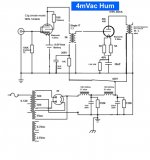I'm a big fan of plate chokes so starting a thread to compare experiences and see who else out there is a fan. As for what's available, we have these for starters.
Hammond 126C - 15mA - 106H - 3.7K
Hammond 126B - 30mA - 44H - 178R
Hammond 157G - 40mA - 30H - 595R - used in Hagerman Tuba
Lundahl LL1667 - 15mA - 270H - 2.4K - (other models available)
Lundahl LL1668 - 25mA - 100H - 680R - (other models available)
Plus many others from smaller transformer winders. For instance, I use NP Acoustics amorphous chokes from Vietnam which I like a lot.
What are your experiences of plate chokes and hot tips for good ones?
Hammond 126C - 15mA - 106H - 3.7K
Hammond 126B - 30mA - 44H - 178R
Hammond 157G - 40mA - 30H - 595R - used in Hagerman Tuba
Lundahl LL1667 - 15mA - 270H - 2.4K - (other models available)
Lundahl LL1668 - 25mA - 100H - 680R - (other models available)
Plus many others from smaller transformer winders. For instance, I use NP Acoustics amorphous chokes from Vietnam which I like a lot.
What are your experiences of plate chokes and hot tips for good ones?
The only problem i have with them apart from the price is that the ones able to withstand normal use currents for usefull bandwidth are really heavy!Then you need serious Shielding...
The Hammonds are quite affordable and the Lundahls not overpriced, but yes, they cost more than a basic tube or SS anode load, and yes they do add size and weight. For an input stage 15mA is pretty decent and most models will do that.
Shielding? Can we talk more about this?
Lundahl LL1668 - great, nice wide bandwidth, sound excellent
Lundahl LL1667 - less great, curtailed HF bandwidth, sound dull compared to LL1668
both using tubes with Rp between 1K and 2K5
haven't tried Hammond chokes as choke load, but I do use them in PSUs
I have found the Lundahls will pickup stray fields when the amp is off, but they are ok once the amp is up and running and I haven't needed to screen them so far
Lundahl LL1667 - less great, curtailed HF bandwidth, sound dull compared to LL1668
both using tubes with Rp between 1K and 2K5
haven't tried Hammond chokes as choke load, but I do use them in PSUs
I have found the Lundahls will pickup stray fields when the amp is off, but they are ok once the amp is up and running and I haven't needed to screen them so far
Lundahl LL1668 - great, nice wide bandwidth, sound excellent
Lundahl LL1667 - less great, curtailed HF bandwidth, sound dull compared to LL1668
both using tubes with Rp between 1K and 2K5. haven't tried Hammond chokes as choke load, but I do use them in PSUs. I have found the Lundahls will pickup stray fields when the amp is off, but they are ok once the amp is up and running and I haven't needed to screen them so far
That's what I heard - the LL1668 is better, much lower resistance. I don't have any, though I've used just the primary of LL1660/18mA. I have a pair of 126B which also sound OK. Haven't compared them in a proper A-B test. I'd like to have a bit of a shootout with my 2 types of NP Acoustics amorphous ones. I also have some 157G which is a budget choice.
You're a fan of plate chokes?
That's what I heard - the LL1668 is better, much lower resistance. I don't have any, though I've used just the primary of LL1660/18mA. I have a pair of 126B which also sound OK. Haven't compared them in a proper A-B test. I'd like to have a bit of a shootout with my 2 types of NP Acoustics amorphous ones. I also have some 157G which is a budget choice.
You're a fan of plate chokes?
Yes, I like them, I have had some really nice results.
<sweeping generalisations>
RC coupled tends to sound the most direct and punchy, with the best drive and rhythm
Transformer coupled the most ethereal with a lovely walk in midrange, but often lacks the last bit of sparkle at the top, and lacks real kick and dynamic at the bottom, compared to RC coupled
LC coupled is somewhere between the two. With a good choke you can still have the HF sparkle similar to RC coupling, and more of a kick and dynamic bass than with an IT (but still not quite as direct as RC) but you do get a good bundle of that open walk in midrange.
</sweeping generalisations>
in the end, as per usual, it's about horses for courses, and there will be people who strongly prefer one over the others, for either technical or aesthetic reasons, and that is fine, it's about whatever works for you
I don't have any, though I've used just the primary of LL1660/18mA.
Тhe 1668 sounds significantly better than the primary. Square waves also look much cleaner with the choke.
Used to be a big fan of the 1668 but in more recent times they have been delegated to PS duties. As plate loads they just don't make much sense as the bottle neck is still the coupling cap. Using a decent (non-Lundahl) interstage transformer works a lot better for me.
Тhe 1668 sounds significantly better than the primary. Square waves also look much cleaner with the choke.
Used to be a big fan of the 1668 but in more recent times they have been delegated to PS duties. As plate loads they just don't make much sense as the bottle neck is still the coupling cap. Using a decent (non-Lundahl) interstage transformer works a lot better for me.
That's useful info on the square waves - thanks!
The coupling cap...... I use Russian Teflon FT-2 and that sounds very clear and detailed to me. Some say teflon sounds cold, but I don't want the PIO kind of warmth. Any other thoughts on the coupling cap? It's a good part of the deal.
Siemens MKV, Miflex KPCU
Have you compared these to FT-2 teflon?
The Miflex looks interesting.
"Any other thoughts on the coupling cap? "
I also generally use russian teflon caps (decades ago collected from military surplus) .... but in the critical positions (between stages) exclusively puts V-Cap CuTF (Copper Foil Fluoropolymer Film).
It's big and heavy, costly as hell, but worth it.
Tried another copper foil capacitors (Audyn, Jensen, Miflex), but V-Cap is better.
I also generally use russian teflon caps (decades ago collected from military surplus) .... but in the critical positions (between stages) exclusively puts V-Cap CuTF (Copper Foil Fluoropolymer Film).
It's big and heavy, costly as hell, but worth it.
Tried another copper foil capacitors (Audyn, Jensen, Miflex), but V-Cap is better.
Interstage coupled architecture is very different from choke loaded, capacitor coupled ones: apples and oranges.
Using such high inductance choke (even in the power chain) in the IT coupled design not reasonable.
Using such high inductance choke (even in the power chain) in the IT coupled design not reasonable.
Its always a matter of "voicing" amplifiers, I have Vcap, Mundorf silver, Miflex, MKV, Duelund here. Generally I avoid teflon in caps and cables.
Euro21 - why do you say this?
Thomas Mayer aka Vinylsavor use plate chokes also as last choke in the power supply of preamps and driver stage. I use it in my LCR phono with great sucess
Generally I avoid teflon in caps and cables.
A kindred soul 🙂
I once bought a 100m of OCC wire in teflon. The only way it is usable is with the teflon stripped off. Which is annoying, takes time, damages the metal surface, but so much worth it. Wire then goes into а polyethylene hose.
Similarly, went through the excruciating process (burn in) of trying to like teflon caps and stay fashionable. Didn't work.
Have you compared these to FT-2 teflon?
The Miflex looks interesting.
I have also all russian caps testet and when you like uncoloured and direct sound the silver mica is best. Its availible in 0.1uf
A kindred soul 🙂
I once bought a 100m of OCC wire in teflon. The only way it is usable is with the teflon stripped off. Which is annoying, takes time, damages the metal surface, but so much worth it. Wire then goes into а polyethylene hose.
Similarly, went through the excruciating process (burn in) of trying to like teflon caps and stay fashionable. Didn't work.
I use mostly silk or cotton when no high voltage is applied. Teflon has something I don't like, a kind of homogenisation.
- Home
- Amplifiers
- Tubes / Valves
- Plate chokes - choosing and using

